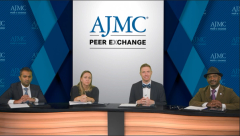
SWOG777 Trial and DRd vs VRd
Medical experts explore the SWOG-S0777 trial and present an overview of daratumumab in combination with lenalidomide and dexamethasone (DRd) vs bortezomib, lenalidomide, and low-dose dexamethasone (VRd).
Episodes in this series

Ryan Haumschild, PharmD, MS, MBA: What do we think about when we look at the MAIA study [data (NCT02252172)] compared [with those of] the S0777 study [NCT00644228]? Just as a background, this is the one that involved bortezomib, lenalidomide, and dexamethasone vs lenalidomide and dexamethasone. Talk to us a little bit about that trial, and then give us a little bit of your thoughts around your comparing DRd [daratumumab + lenalidomide + dexamethasone] vs VRd [bortezomib + lenalidomide + low-dose dexamethasone], and how do you stratify patients between those 2?
Brea C. Lipe, MD: I would also like to just say, at least for me, one of the issues that I have in clinic when I’m talking to patients is the idea that multiple myeloma is a chronic disease, because I think that as our treatments are getting better and patients are staying on treatment longer, it is a nice concept to kind of introduce patients to the idea that they will be on therapy lifelong. But I think to some extent when we think of chronic diseases––not that this is completely accurate––…we think of diabetes, and people…minimize the severity of those [diseases]. Not that they should, but I think that’s just what the nomenclature means, and I like to reinforce my patients [with the idea] that, “You’ll be on therapy for the rest of your life; this is a fatal disease.” Any terminology that minimizes that impact puts us at risk for patients coming off therapy too soon or things like that. So that’s…a thing that I like to reinforce [with] my patients.
Back to S0777, I think that this was an important study because it was one of the first studies to really establish the efficacy of triplets over doublets. This is an older study now with about 84 months of follow-up and, as you mentioned, it was comparing lenalidomide + bortezomib + dexamethasone vs lenalidomide + dexamethasone induction, and then lenalidomide + dexamethasone maintenance. This study[‘s findings were], again, the first to demonstrate an improvement in overall survival with the use of a triplet. In the study, the PFS [progression-free survival] was about 41 months vs 29 months for the len/dex [lenalidomide + dexamethasone] arm, and then the overall survival over 84 months for the bortezomib + lenalidomide + dexamethasone. It was really important for that reason, but then I always like to remember that these trials were not designed to be compared [with] one another. S0777 and MAIA, they weren’t designed to be compared, but because these are now triplet regimens that we have, we have to understand them in context with one another. There are a few differences in the trial design. One of them, namely, the number of older patients in the trial or the age of the patients within the trial. In S0777, most of the patients were actually under the age of 65, with only 43% of patients being over the age of 65. When you compare that [with] MAIA [data], about 99% of patients were over the age of 65. To some extent, we’re really looking at a difference in patient population in terms of age. There were also more high-risk patients in the S0777 trial vs in the MAIA trial, so that gave us probably a little more power to demonstrate that there is an improvement, or trend toward improvement, in progression-free and overall survival with the lenalidomide + bortezomib + dexamethasone that we didn’t see in the MAIA trial, at least as of now. S0777 is a little more mature, so we have the ultimate overall survival data, and we still don’t have that data from MAIA in terms of the DRd arm. Those are…the main differences that we saw in terms of trial design, but then we look at another important thing, which is toxicity, as has been mentioned. When you compare the toxicity in terms of dropout rates from the S0777 vs DRd in the MAIA arm, the dropout rate due to adverse events in S0777 was about 23% vs about 13% in the MAIA trial, and I think one of the challenges with that is S0777 was an older design, so when they use bortezomib and dexamethasone in that trial, they use bortezomib in the conventional day 1, 4, 8, 11, and they use a lot of dexamethasone in that study. Subsequently, there have been other studies looking at other ways to combine lenalidomide and bortezomib in sort of an RVd lite or premium lite mechanism to reduce some of that toxicity, but I think that accounts for some of the differences in the dropout rates that we saw between the 2 trials. Those I think are really the important differences between those 2 trials, and when you look overall at how those patients are doing, we definitely saw a benefit for the triplet arms vs the doublet arms, with the data from S0777 demonstrating the overall survival benefit. We’re seeing that in MAIA, but the actual overall survival medians have not been reached [and] nor have the PFSs, but right now we’re at…56 months, and we don’t have the medium PFS for MAIA.
Ryan Haumschild, PharmD, MS, MBA: I appreciate your giving that background on the trials as well and the comparison and contrast in terms of what you can compare, what you cannot, and how you would stratify patients based on the trial inclusion criteria. I think that’s really helpful as we’re looking at driving practitioner use across regimens for the unique patients. And one of the things you also highlighted that I thought was so important is the triplet vs doublet, and I got to hear your input on that as well. Dr Nadeem, I’m curious [about] your thoughts as well. When you think about our approach to selecting patients and induction regimens, what is your thought on a triplet vs doublet? Does it correlate with what we heard before or do you have a different take?
Omar Nadeem, MD: No, I think my colleagues here did a great job summarizing the history of myeloma therapy and how it came from different eras. We started with conventional chemotherapies and steroids onto a doublet with lenalidomide + dexamethasone, and then several trials in the relapse setting showed the benefit of triplet, and then we heard about the up-front trials showing the same benefit. I think we moved on from the doublet to the triplet era, and now we’re in the quadruplet era, right? The field is moving, and the good news is you can combine all these therapies because they can be combined without adding too much toxicity. I think we’ve moved beyond doublets for the majority of our patients. Are there a handful of patients, very elderly, that you don’t think would be able to tolerate a triplet? Sure, we all have those in our practice; but I would say for the vast majority of [patients] newly diagnosed [with] myeloma, they should be at least getting the triplet. We’re doing now a lot of quadruplets with the transplant-eligible population, and I think a lot of this highlights the dosing. We have all these conventional dosing strategies, which is what the trial studied, but there are a lot of dose modifications that occur in these trials or in clinical practice, and I think what we’ve learned is now that you have so many different agents with so many different mechanisms of action that you don’t feel the need to push too hard with one particular one, right? A classic example is lenalidomide being dosed at 25 mg for 3 weeks on and 1 week off in a patient that’s over 80 years old. That doublet with dexamethasone may be more toxic than a triplet when lenalidomide is actually dosed at 15 mg, which is what they’ve done for the RVd-lite platform, right? I think a lot of this comes down to individual dosing for the patient using bortezomib weekly, using a lower-dose lenalidomide, and definitely using lower-dose steroids. All of these things have been validated and they allow patients to stay on therapy longer and derive benefit as opposed to having a more…intense schedule. In our practice, it’s mostly all triplets for patients that are transplant ineligible, and even some quadruplets for patients that are transplant eligible, particularly the high-risk patients, again, with substantial dose modifications. We’re in the middle of that shift now. Certainly by no means is that standard of care, but [it’s] just to give you a sense as to where the field is going.
Ryan Haumschild, PharmD, MS, MBA: Well, it’s great to hear. We were talking about doublet versus triplets, but I’m glad you talked about the quadruplets. I think you’re right. There’s always a patient-specific conversation and how we can create that emerging data to really provide as best front-line efficacy as we can.
Transcript edited for clarity.
Newsletter
Stay ahead of policy, cost, and value—subscribe to AJMC for expert insights at the intersection of clinical care and health economics.

















































